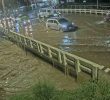In a statement emailed on Wednesday and dated December 5, Ka Oris, spokesperson of NDFP-Mindanao said the ceasefire order given to the New People’s Army in the typhoon-hit areas is meant to “pave the way for a safe, unhampered and speedy rescue of victims, and to conduct a speedy and unhampered relief operations in the affected communities.”
By MARILOU AGUIRRE-TUBURAN
Davao Today
DAVAO CITY, Philippines — The National Democratic Front of the Philippines in Mindanao (NDFP-Mindanao) declared a 29-day unilateral ceasefire in response to the super typhoon that affected millions all over Mindanao.
In a statement emailed on Wednesday and dated December 5, Ka Oris, spokesperson of NDFP-Mindanao said the ceasefire order given to the New People’s Army (NPA) in the typhoon-hit areas is meant to “pave the way for a safe, unhampered and speedy rescue of victims, and to conduct a speedy and unhampered relief operations in the affected communities.”
The ceasefire started on December 5 at 12 noon and will last until January 3, 2013 of the same time. “The ceasefire shall continue, if necessary, depending on the result of the assessment in the conduct of ceasefire,” Ka Oris said.
All NPA units bound by the Ceasefire Declaration, Ka Oris said, are ordered “not to launch tactical offensives” during the specified period. He also urged the military, police and Cafgu (Citizens Armed Force Geographical Unit) “not to use the relief and rescue operations, rehabilitation of communities and COPD (Community Outreach for Peace and Development) as guise of military operations against the NPA and the people in the area.” He warned that in such instances, the NPA reserves the right to defend themselves and the people who have already suffered greatly from the calamity.
The NDFP also said it commiserates with the victims of Typhoon Pablo (International name: Bopha). Ka Oris expressed sympathy to the families of the fatalities and to those who survived the typhoon, especially in Davao Oriental, Compostela Valley, Surigao del Sur and greater part of Mindanao, including Palawan and the Visayas region.
In Davao region alone, data from the Office of Civil Defense (OCD)-XI as of noon December 11 reported a total of 43 municipalities and three cities affected by the storm, affecting 958,050 families or 4,149,787 individuals. The update also said a total of 43,112 families or 198,287 individuals have also been displaced from 49 villages.
Data from the Provincial Disaster Risk Reduction and Management Council also counted a total of 850 recovered bodies while 611 individuals remain missing and almost two thousand injured.
“We also express our sympathy to the grieving families and friends of the AFP (Armed Forces of the Philippines) soldiers who died in the flashfloods in New Bataan, Compostela Valley,” Ka Oris said.
OCD-XI also noted a total of 54 communal and national irrigation systems that were damaged with an estimated worth of PHP 820,000 while infrastructure suffered another almost three billion pesos worth of damage.
Typhoon Pablo also caused an estimated almost eight billion pesos in damages to the region’s agriculture, according to Agriculture Secretary Proceso Alcala in a press briefing here Friday.
“We’re also calling on all NPA units in the affected areas to help, if the security situation and their resources permit, rescue the victims, retrieve their dead, distribute relief goods and rehabilitate the community,” Ka Oris said.
He called on revolutionary forces and the people to gather resources “to show once more” their concern to the victims as he demanded that “all big mining and logging corporations and plantations share a reasonable amount for the relief and rehabilitation.”
Meanwhile, NDF-Southern Mindanao spokesman Rubi del Mundo also called for the massive rescue, relief and rehabilitation assistance and urged its allied revolutionary organizations to raise funds, seek donations and contributions for the victims in a statement dated December 6.
In the same statement, Del Mundo criticized the “poor disaster-preparedness” of the Aquino administration. The statement also said it was ironic that the Aquino government looks to the provinces of Compostela Valley and Davao Oriental as resource-rich localities in the country but “nowhere can we see the hundreds of millions of pesos of taxpayers’ money out of ComVal (Compostela Valley)’s mining, agribusiness and Davao Oriental’s logging resources working for the victims of this calamity.”
Compostela Valley has an estimated 189 million metric tons of gold deposits mostly found in Mt. Diwata in Monkayo town and 490.7 million metric tons of nickel deposits also in Compostela Valley and Davao Oriental.
“Yet, as tragedies strike the resource-laden but poor communities, all the government can do is to deliver piecemeal assistance,” Del Mundo said, pointing out that “the billions of pesos allocated by the US-Aquino regime in AFP modernization, in the implementation of the fascist Oplan Bayanihan, and in disaster-related technological upgrade, the high-tech gadgets have failed to save the lowly peasant families, the families of small-scale miners and the ordinary banana plantation workers.”
‘Climate change’
“Walang mga bagyo na ganyan kalakas sa Mindanao (There are no storms of this strength in Minanao). This is the first time,” said Joselin Marcus Fragada, Director of the Department of Environment and Natural Resources-XI Friday in a press briefing with President Noynoy Aquino at the Davao International Airport.
He added “The forest covers are depleted. Ang mga kabundukan nagkukulang na sa puno (The mountains have fewer trees).” What happened in the Davao Region, he said, “is a result of climate change and global warming.”
Ka Oris said that the Imperialist and local ruling class worked hand in hand to create the condition that changed the world’s climate because of the greed for superprofits.
Hardest hit in the region are the towns of Baganga, Cateel and Boston in Davao Oriental and New Bataan and Monkayo in Compostela Valley.
“These are the areas where the vast plantations of Dole and Sumifru (Sumitomo Fruits) are located including the large-scale mining company Indo-phil,” Ka Oris said. He added, the mountains of Diwata that connect these towns have been destroyed in the past 50 years by large-scale logging companies from the US and Japan “in collusion with the local bourgeois compradors like the Valderramas, Alcantaras and the Sorianos.”
“Now that the remaining forest covers (in Compostela Valley and Davao Oriental) are gone, we shall expect the negative effects to our environment that will possibly result in stronger typhoons in the future, including the possibility of longer La Niña and El Niño,” Ka Oris said.
As the death toll rises and many beg for help in the typhoon-affected areas, Del Mundo urged the people, including the families of the victims of the calamity to “struggle to hold accountable those responsible for the loss of lives and property.”
Meanwhile, Ka Oris urged the people to unite and save the environment and to “struggle against large-scale environmental plunder by the Imperialist and local ruling class.” (Marilou Aguirre-Tuburan/davaotoday.com)










